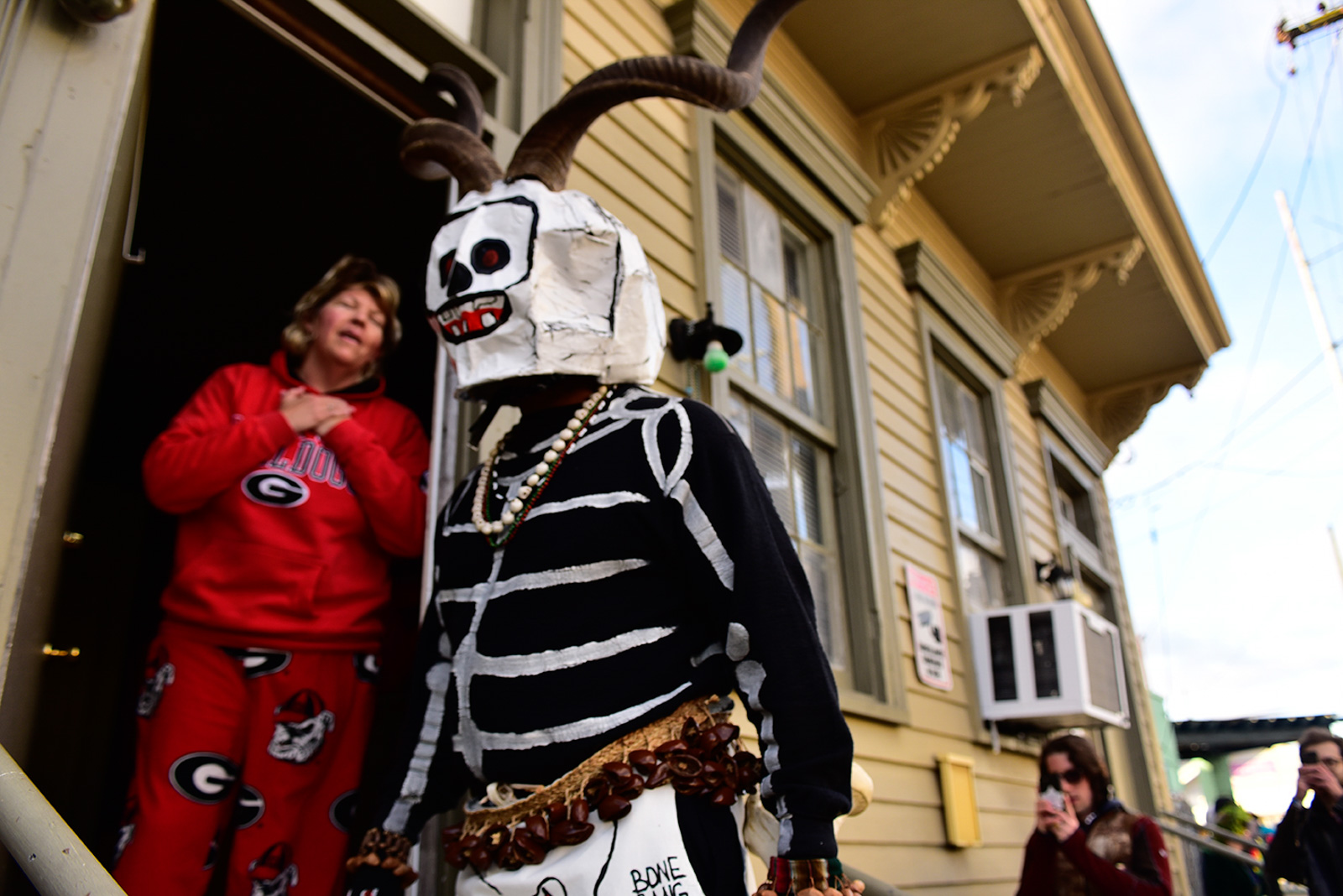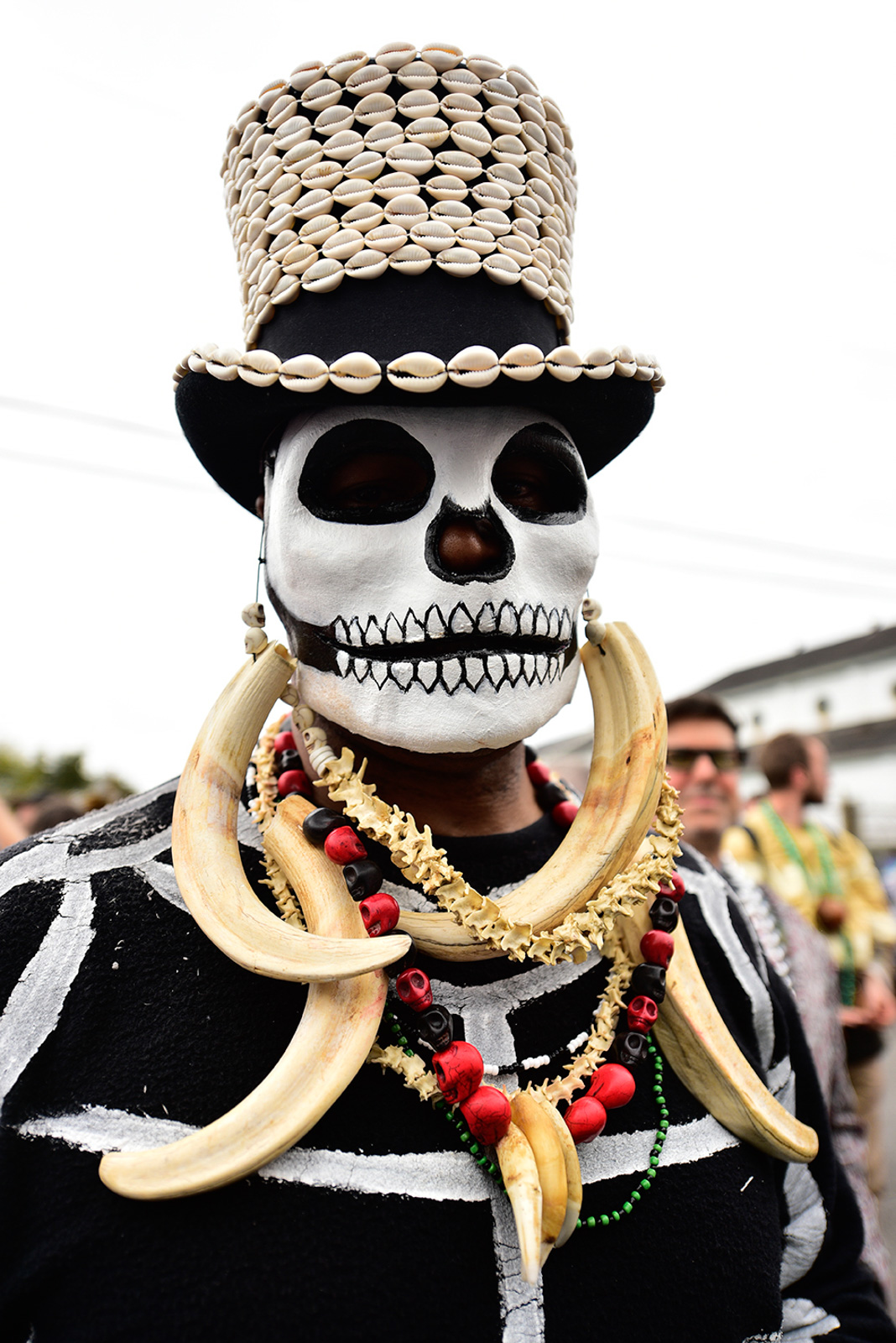These maskers, dressed as skeletons and wielding scary-looking spears and large bones, wake up the Tremé neighborhood on Mardi Gras morning with a warning: Get your act together before it’s “too late.” They evoke the literal meaning of Carnival — farewell to the flesh — and serve as a reminder that Carnival, like death, is a great equalizer.
Messaging mortality
To the uninitiated, the skeleton-masking North Side Skull and Bone Gang — representing, on the most basic level, death — might seem out of place on Mardi Gras. They’re not trying to be the prettiest anything or partake in the giddy fantasies typically associated with the “Greatest Free Show on Earth.”
They come out before dawn, in the vicinity of the Tremé neighborhood, and keep it on the real. Frivolity is not their thing. They’re menacing, in fact, with oversized skull heads crafted from bale wire and papier-mâché; gloved hands gripping massive meat bones; intimidating spears made with antelope horns; and aprons scrawled with skulls, bones and their signature catchphrase: “You Next.” There’s primal drumming and chanting, along with intonations and songs from Big Chief Bruce “Sunpie” Barnes, who is known to adorn himself with huge alligator teeth and have the horns of an African water buffalo protruding from his skull head.
Big Chief Sunpie paying a visit on Mardi Gras 2019
An emissary of the dead, his raps and pronouncements cut to the bone.
Photo © Lisa DuBois
Back in the day, Mardi Gras skeletons would wake up the Tremé and send children scrambling in fear — warning them of a scary comeuppance if they didn’t stay in school and out of trouble. Their costumes were simple but effective. Long johns dyed black, with bones painted on them, did the trick. The skull heads were sculpted with wire and covered with cheese cloth, then painted with multiple coats of white enamel. It was an inexpensive way for Black men to participate in Carnival, at time when people of their race were not welcomed in the “official” celebration.
The essential accessory came fresh from the meat market. “Everybody had a bone,” Alfred Morris, who preceded Sunpie as chief, explained in the 2003 documentary All on a Mardi Gras Day, which explored African American Carnival traditions. “And the bloodier it was, the more meat it had on it, the better it looked.” (The film’s writer and producer, Royce Osborne, who died in 2017, masked as a bone man. Morris died in 2011.)
Under Sunpie, the North Side Skull and Bone Gang has broadened the Scared Straight program to all age groups. The chief’s ominous raps and pronouncements, about taking stock of one’s life before it’s too late, have a way of cutting to the bone.
On Mardi Gras morning
I hear the tambourine ring
You gonna wake up one morning
Find your own self dead
Oh the next thing you know, boy
They’re tossin’ dirt on your head
After each line, the crowd chants “Too late!”
Ashes to ashes
And dust to dust
You keep poppin’ them pills
You gotta come see us
Sunpie channels Baron Samedi, the rambunctious guardian of the graveyard in the spiritual pantheon of Voodoo, which came to New Orleans mostly by way of Haiti. (His female counterpart is Manman Brigitte.)
I don’t wear no feathers
I ain’t got no crown.
I’m the Big Chief
From the hole in the ground
Sunpie on Mardi Gras 2020
The top hat and skeleton face evoke the “Master of the Cemetery” or “Master of the Dead,” Baron Samedi, a loa or spirit deity in Haitian Voodoo who urges humans to live life to the fullest before it’s too late. Haiti also has skeleton maskers and may have been the original source of the Mardi Gras skull-and-bone tradition.
Photo © Lisa DuBois
He’s mysterious and stealthy: “I come without a warning… ready to dig a hole in the ground [and] dance all around” when one’s time is up and it’s “too late to cry.”
The bone men evoke the literal meaning of Carnival — farewell to the flesh — and serve as a reminder that Carnival, like death, is a great equalizer. Anyone can join in the fun and be king or queen for a day but none, in the end, can escape the grasping reaper.
It all makes sense in a city where celebration and death, as exemplified by the jazz funeral tradition, have long been closely connected. The omnipresence of disaster — in the form of vengeful floods and hurricanes (and, in the old days, cholera and yellow fever) — may help explain the propensity of the citizenry to seek delight in the here and now. As Frederick Turner once observed in a New York Times travel supplement, “the city’s hectic gaiety seems raised above the reaching arms of death.”
In bringing the spirits of the dead to the streets on Mardi Gras, Sunpie is a formidable presence with impressive credentials. A native of Arkansas, he played one season of professional football with the Kansas City Chiefs and went on to fulfill a childhood dream by working as a park ranger — first at Jean Lafitte National Historical Park, Barataria Preserve, and later at the New Orleans Jazz National Historical Park. He specialized in creating educational programs, tours and curricula, as well as developing partnerships with governmental agencies, community-based organizations, musical groups and educational institutions. He developed a passion for fine art photography and producing ethnographies of South Louisiana culture — expertise that led to an ongoing affiliation with the University of New Orleans and its Neighborhood Story Project.
But Sunpie is best known as a recording artist and band leader. He has developed an original genre he calls “Afro-Louisiana music,” incorporating Louisiana Creole with blues, zydeco, gospel, Caribbean and African music. Sunpie and the Louisiana Sunspots has performed in over 50 countries. Its frontman sings and plays accordion, harmonica, piano, rub board, talking drum and more. He has his own music publishing company and has licensed over 20 songs in film and television.
Sunpie joined the North Side Skull and Bone Gang in 1999 and, with Morris ailing, took over as chief in 2010. While the group has kept up the tradition of awakening the Tremé on Mardi Gras, its scare tactics are more gentle than in days gone by. Admonitions of mortality are mixed with interludes of dance, fueled by a potent contingent of African-style drummers.
On their trek, the bone gang and its followers periodically stop to invite — or command — individuals to step into a circle and dance. Those who abandon themselves to the propulsive beats of the drums draw cheers. Then the procession resumes, with Sunpie knocking on doors to see who’s home — visitations that may result in a resident doing an impromptu dance on their doorstep.
The message of the bone men is, in the end, nuanced. Better straighten up before it’s too late, yes indeed. But enjoy today what might be gone tomorrow. In other words, “Eat, drink and be merry, for tomorrow we may all die!”
MardiGrasTraditions.com


